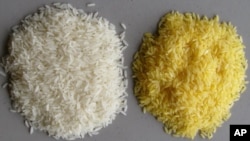ທີ່ຟີລິບປິນ ບັນດານັກວິທະຍາສາດກຳລັງດຳເນີນງານກ່ຽວກັບພັນເຂົ້າຊະນິດນຶ່ງ ທີ່ສາມາດແກ້ໄຂບັນຫານຶ່ງໃນບັນດາການທ້າທາຍໃຫຍ່ໆຕໍ່ສຸຂະພາບໄດ້ ກໍຄື: ການຂາດແຄນໄວຕາມິນ A. ພັນເຂົ້າທີ່ເອີ້ນວ່າ “ເຂົ້າຄຳ” ແມ່ນໄດ້ມາຈາກການຕັດແຕ່ງພັນທຸກຳ ເພື່ອໃຫ້ຜະລິດສານ beta carotene ຊຶ່ງໄດ້ພາໃຫ້ມີການຄັດຄ້ານຈາກພວກທີ່ຄັດຄ້ານ ຕໍ່ພືດທີ່ຖືກຕັດແຕ່ງພັນທຸກຳ ທີ່ເອີ້ນວ່າ GMO ນັ້ນ ແລະຈາກພວກອະນຸລັກສິ່ງແວດລ້ອມ ຮວມທັງອົງການ Greenpeace ນຳ. ຜູ້ສື່ຂ່າວວີໂອເອ Simone Orendain ມີລາຍງານກ່ຽວກັບ ການຖົກຖຽງກັນ ກ່ຽວກັບພັນເຂົ້າທີ່ມີສີເຫຼືອງຄຳດັ່ງກ່າວນີ້ ຊຶ່ງສິງຈະນຳມາສະເໜີທ່ານ.
ສຳຫລັບພວກສະໜັບສະໜຸນນັ້ນ ພັນເຂົ້າຄຳແມ່ນມີຄວາມສາມາດບົ່ມຊ້ອນຢ່າງຫຼວງຫຼາຍ ໃນການທີ່ຈະຊ່ວຍຜູ້ຄົນໄວ້ໄດ້ ຫຼາຍເຖິງ 2 ລ້ານຄົນໃນແຕ່ລະປີ ບໍ່ໃຫ້ເສຍຊີວິດໄປ ຍ້ອນ
ຂາດແຄນໄວຕາມິນ A ທີ່ສົ່ງຜົນກະທົບຕໍ່ພວກເດັກນ້ອຍແລະພວກແມ່ຍິງຖືພາມານເປັນ
ສ່ວນໃຫຍ່ນັ້ນ.
ສານ beta carotene ຢູ່ໃນເຂົ້າພັນໃໝ່ນີ້ ແມ່ນເປັນສານເບື້ອງຕົ້ນໃນການຜະລິດໄວຕາມິນ A ທີ່ບໍ່ມີຢູ່ໃນພວກອາຫານຂອງປະຊາກອນຫຼາຍລ້ານຄົນໃນໂລກພວມພັດທະນາ. ການຂາດໄວຕາມິນ A ເປັນສາເຫດຊັ້ນນຳຂອງພະຍາດຕາບອດຂອງພວກເດັກທີ່ຍັງນ້ອຍຢູ່ ແລະເປັນບັນຫາດ້ານສາທາລະນະສຸກ ຢູ່ໃນເຄິ່ງນຶ່ງຂອງໝົດທຸກປະເທດ ແລະຫຼາຍໆປະເທດໃນອາຟຣິກາ ແລະເອເຊຍຕາເວັນອອກສຽງໃຕ້.
ສຳຫລັບທ່ານ Patrick Moore ນັກນິເວດວິທະຍາຈາກການາດາ ແລ້ວ ກໍແມ່ນວ່າ ບໍ່ຄວນ
ຈະມີການຖົກຖຽງກັນເລີຍກ່ຽວກັບວ່າ ພວກກະສິກອນຄວນຈະປູກເຂົ້າພັນສີຄຳນີ້ ຫຼືບໍ່.
ທ່ານ Moore ກ່າວວ່າ “ເປັນຫຍັງ ຈຶ່ງບໍ່ມີຄວາມລັງກຽດແບບດຽວກັນນີ້ ຕໍ່ເລື້ອງ
ທີ່ພວກເດັກນອຍ 2 ລ້ານຄົນກຳລັງຈະຕາຍໄປ? ຄວນຈະມີການນຳເອົາເຂົ້າ
ພັນນີ້ ອອກເຜີຍແຜ່ເພື່ອໃຫ້ ຢ່າງໜ້ອຍປະຊາຊົນ ບາງຄົນ ສາມາດໄດ້ຮັບເຂົ້າ
ນີ້ໄປບໍລິໂພກ ແລະບາງທີ ຖ້າຫາກມີການປູກເຂົ້ານີ້ຫລາຍຕື່ມຂຶ້ນອີກ ກໍຈະມີ
ຄົນຈຳນວນຫລາຍຂຶ້ນໄດ້ຮັບຜົນປະໂຫຍດ.”
ແຕ່ພວກຕຳໜິຕິຕຽນພັນເຂົ້າຄຳ ຮວມທັງກຸ່ມປົກປ້ອງສິ່ງແວດລ້ອມ Greenpeace ໄດ້ຄັດຄ້ານຕໍ່ພັນເຂົ້າຄຳນີ້ມາເປັນເວລາດົນນານ ຍ້ອນວິທີການຕັດແຕ່ງພັນທຸກຳ ທີ່ພົວພັນ
ນຳການຜະລິດເຂົ້າພັນນີ້. ທ່ານ Moore ເຄີຍເປັນສະມາຊິກມາກ່ອນຂອງກຸ່ມ Green
peace ໃນຊຸມປີ 1970 ແລະໃນຕົ້ນຊຸມປີ 1980. ແຕ່ໄດ້ຫັນປ່ຽນມາເປັນຜູ້ທີ່ຕຳໜິຕິ
ຕຽນທ່າຢືນຂອງກຸ່ມດັ່ງກ່າວ ກ່ຽວກັບເລື້ອງຕ່າງໆຫຼາຍເລື້ອງ ຮວມທັງພັນເຂົ້າຄຳນີ້ນຳ.
ໃນການຕອບຕໍ່ຂໍ້ຊັກຖາມກ່ຽວກັບການຕຳໜິຕິຕຽນຂອງທ່ານ Moore ນັ້ນ ກຸ່ມ Green
peace ໄດ້ສົ່ງຖະແຫຼງການທາງ e-mail ຊີ້ແຈງວ່າ “ພືດທີ່ຖືກຕັດແຕ່ງພັນທຸກຳນັ້ນ
ເກືອບວ່າທັງໝົດ ແມ່ນຖືກດັດແປງໃຫ້ ທົນທານຕໍ່ຢາຂ້າແມງໄມ້ຫລືສັດຕູພືດ ທີ່
ສົ່ງໄປຂາຍໃນຕະຫຼາດໃນບັນ ດາປະເທດກຳລັງພັດທະນາ” ແລະວ່າ ຮູບແບບການ
ປ່ຽນແປງລັກສະນະທຳມະຊາດຂອງມັນ ສົ່ງຜົນເສຍຫາຍຕໍ່ສຸຂະພາບຂອງຄົນ ຕໍ່ຊີວິດ
ການເປັນຢູ່ຂອງພວກກະສິກອນ ແລະສິ່ງແວດລ້ອມ.
ແຕກຕ່າງຈາກພວກພືດທີ່ຖືກຕັດແຕ່ງພັນທຸກຳບາງຢ່າງ ທີ່ອອກ
ແບບໂດຍພວກບໍລິສັດຕ່າງໆທີ່ຖືສິດທິບັດ ຫຼືປາຕັງສຳຫລັບພື
ເຫຼົ່ານັ້ນ ພັນເຂົ້າຄຳນີ້ ແມ່ນພັດທະນາຂຶ້ນມາໃນຟີລິບປິນ ໂດຍ
ໄດ້ຮັບເງິນທຶນຈາກລັດຖະບານ. ມີອົງການກຸສົນແລະກຸ່ມຕ່າງໆ
ຈາກພາກລັດ ຈຳນວນນຶ່ງ ດຳເນີນງານເພື່ອປັບປຸງການຜະລິດ
ພັນເຂົ້າຄຳນີ້ ໃຫ້ໄດ້ຜົນຫຼາຍຂຶ້ນ ໂດຍຫວັງວ່າ ພວກກະເສດຕະ
ກອນໃນບັນດາປະເທດກຳລັງພັດທະນາຈະພາກັນປູກເຂົ້າພັນນີ້
ໃນທີ່ສຸດ ຊຶ່ງຈະເປັນການແກ້ໄຂບັນຫາສາທາລະນະສຸກທີ່ສຳຄັນ
ບັນຫານຶ່ງ ທີ່ນັກວິທະຍາສາດຫຼາຍຄົນກ່າວວ່າ ຮ້າຍແຮງໃນລະ
ດັບດຽວກັບພະຍາດໄຂ້ຍຸງ ຫລືວັນນະໂຣກ ກໍຄືໂຣກປອດແຫ້ງນັ້ນ.
ແຕ່ທ່ານ Daniel Ocampo ຜູ້ປຸກລະດົມດ້ານການກະເສດຂອງກຸ່ມ Greenpeace ປະຈຳ
ເອເຊຍຕາເວັນອອກສຽງໃຕ້ທີ່ມີຫ້ອງການຢູ່ ນະຄອນຫລວງມານີລາ ກ່າວວ່າ ຫຼັງຈາກທຳ
ການຄົ້ນຄວ້າມາເປັນເວລາ 20 ປີແລ້ວ ພັນເຂົ້າຄຳນີ້ກໍຍັງບໍ່ທັນພ້ອມສຳຫລັບການບໍລິໂພກ
ເທື່ອ ແລະອາດສາມາດເປັນອັນຕະລາຍ ຫຼາຍກວ່າທີ່ພວກສະໜັບສະໜຸນຈະຍອມຮັບກໍໄດ້.
ທ່ານ Ocampo ກ່າວວ່າ “ມັນຍັງຢູ່ໃນຫ້ອງຄົ້ນຄວ່າຢູ່ ມັນຍັງບໍ່ທັນມີຂາຍເທື່ອ.
ສະນັ້ນ ແທ້ຈິງແລ້ວ ມັນເປັນການເຮັດໃຫ້ຜູ້ຄົນເຂົ້າໃຈຜິດ ເວລາພວກເຂົາ
ເຈົ້າກ່າວວ່າ ມັນຈະເປັນທາງອອກນຶ່ງ ຕໍ່ບັນຫາການຂາດແຄນໄວຕາມິນ A.”
ແທນການສະໜັບສະໜຸນພືດ GMO ນັ້ນ ກຸ່ມ Greenpeace ໄດ້ຫັນໄປຊຸກຍູ້ອັນທີ່ຕົນ
ເອີ້ນວ່າ “ການກະເສດນິເວດວິທະຍາ” ທີ່ປັບປ່ຽນໄປກັບດິນຟ້າອາກາດ ແລະຈະອຳນວຍ
ໃຫ້ປະຊາຊົນໄດ້ຮັບອາຫານທີ່ຖືກຕ້ອງຕາມຄວາມຕ້ອງການດ້ານໂພຊະນາການຂອງເຂົາເຈົ້າ.
ເມື່ອນຶ່ງປີເຄິ່ງກ່ອນໜ້ານີ້ ກຸ່ມຕໍ່ຕ້ານພືດ GMO ກຸ່ມນຶ່ງໄດ້ເຂົ້າທຳລາຍ ສະຖານທີ່ທົດລອງ
ເຂົ້າຄຳແຫ່ງນຶ່ງ ໃນເຂດ Bicol ຂອງຟີລິບປິນ ເພື່ອປະທ້ວງຕໍ່ຕ້ານໂຄງການດັ່ງກ່າວ ຊຶ່ງ
ໄດ້ພາໃຫ້ເລື້ອງການໂຕ້ແຍ້ງກັນກ່ຽວກັບພັນເຂົ້າຄຳນີ້ ໄດ້ຮັບຄວາມສົນໃຈຢ່າງສູງ ແລະ
ພາໃຫ້ບາງຄົນກ່າວຫາກຸ່ມ Greenpeace ວ່າຢູ່ເບື້ອງຫຼັງການປະທ້ວງ ແລະການທຳລາຍ
ສູນທົດລອງປູກເຂົ້າຄຳນັ້ນ. ແຕ່ທາງ Greenpeace ປະຕິເສດວ່າ ຕົນບໍ່ມີຫຍັງກ່ຽວຂ້ອງ
ກັບເລື້ອງນີ້.
ສະຖາບັນຄົ້ນຄວ້າເຂົ້າລະຫວ່າງຊາດ ທີ່ຕັ້ງຢູ່ທາງທິດໃຕ້ຂອງນະຄອນຫຼວງມານີລາ ບໍ່ໄກ
ປານໃດນັ້ນ ໄດ້ທຳການທົດລອງປະສົມພັນເຂົ້າອື່ນໆກັບເຂົ້າຄຳນີ້ ມາເປັນເວລາ 9 ປີແລ້ວ
ແຕ່ກໍຍັງກ່າວວ່າ ພວກຕົນຍັງຈະຕ້ອງດຳເນີນການຄົ້ນຄວ້າຕື່ມອີກຢູ່ ກ່ອນທີ່ພັນເຂົ້ານີ້ຈະພ້ອມສຳຫລັບນຳມາໃຫ້ຄົນບໍລິໂພກໄດ້.
Scientists in the Philippines are at work on a strain of rice that could solve one of the world’s major health challenges: a vitamin A deficiency. The so-called, “golden rice”, which has been genetically engineered to produce beta carotene, has led to opposition from GMO opponents, including Greenpeace.
To supporters of golden rice, the crop offers enormous potential for eliminating as many as two million deaths each year from vitamin A deficiency, which mainly impacts young children and pregnant women.
The beta carotene in the new rice is a precursor for Vitamin A, which is missing in the diets of millions of people in the developing world. The deficiency is a leading cause of childhood blindness, and is a public health problem in many countries.
Pros vs cons
Canadian ecologist Patrick Moore says there should be no debate over whether farmers should grow golden rice.
“Why is there not the same revulsion at two million children dying," Moore asked. "To let golden rice out so at least some people can get it and maybe more and more and more?”
But critics, including the Greenpeace environmental group, have long opposed the crop because of the genetic engineering involved in its creation. Moore was an early member of Greenpeace in the 1970s and early 80s, but has since become a critic of the group’s stance on a range of issues, including golden rice.
“Genetically engineered crops consist almost entirely of herbicide tolerant and insect resistant crops marketed to developing countries” Greenpeace said in an emailed statement in response to queries about Moore’s criticism. The statement also said the group finds this model detrimental to people’s health, farmers’ livelihoods and the environment.
Public financing
Unlike some genetically modified crops designed by corporations that patent the plants, the golden rice being developed in the Philippines is financed by public funds. A range of philanthropic and public sector groups have worked to engineer the crop and improve its production. They hope that farmers in the developing world will eventually grow it, addressing a major public health issue that many scientists say is on the scale of malaria or tuberculosis.
But Manila-based Greenpeace Southeast Asia Agriculture Campaigner Daniel Ocampo said after 20 years of research golden rice is not ready for consumption, and could be more dangerous than its supporters will admit.
“It’s still in the laboratory. It’s not available commercially," Ocampo said. "So it’s really misleading the public when they say that it’s going to be one of the solutions to Vitamin A deficiency.”
Greenpeace is instead pushing what it calls “ecological agriculture” which it said is climate resilient and will let people access food that meets their nutritional needs.
A year and a half ago, a group of anti-GMO activists overran one of the golden rice test plots in the Philippines' Bicol region and destroyed it in a protest against the project. The incident raised the profile of the conflict over golden rice, and led some to accuse Greenpeace of being behind the protest and the destruction. But the organization says it had nothing to do with it.
The International Rice Research Institute just south of Manila has been doing breeding experiments with golden rice for nine years, but said they must still conduct more research before it is ready for human consumption.






